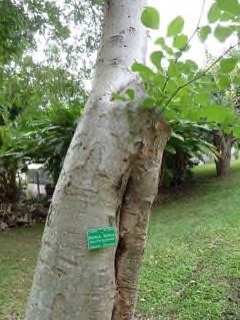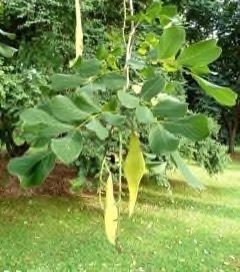 |
|
Wendy Cutler wikimedia.org |
 |
| Wendy Cutler wikimedia.org |
Translate this page:
Summary
Millettia stuhlmannii or commonly known as Panga Panga or Partridge Wood is a deciduous tree native to southeastern Afrotropics. The leaves are compound, large, green, and comprised of seven to nine pairs of opposite leaflets. The trunk is cylindrical and can be up to 120 cm in diameter. Decoction of the root is used in the treatment of stomach pain. The wood is resistant to fungi, dry wood borer, and termites attack. It is heavy and highly durable, making it an ideal flooring and furniture material and for heavy construction.
Physical Characteristics

 Millettia stuhlmannii is a deciduous Tree growing to 15 m (49ft) by 12 m (39ft) at a medium rate.
Millettia stuhlmannii is a deciduous Tree growing to 15 m (49ft) by 12 m (39ft) at a medium rate.
See above for USDA hardiness. It is hardy to UK zone 10. The flowers are pollinated by Insects.
It can fix Nitrogen.
Suitable for: light (sandy), medium (loamy) and heavy (clay) soils and prefers well-drained soil. Suitable pH: mildly acid, neutral and basic (mildly alkaline) soils. It cannot grow in the shade. It prefers moist soil.
UK Hardiness Map
US Hardiness Map
Synonyms
Lonchocarpus mossambicensis Sims
Plant Habitats
Edible Uses
References More on Edible Uses
Medicinal Uses
Plants For A Future can not take any responsibility for any adverse effects from the use of plants. Always seek advice from a professional before using a plant medicinally.
A root decoction is drunk to treat stomach-ache[299 ].
References More on Medicinal Uses
The Bookshop: Edible Plant Books
Our Latest books on Perennial Plants For Food Forests and Permaculture Gardens in paperback or digital formats.

Edible Tropical Plants
Food Forest Plants for Hotter Conditions: 250+ Plants For Tropical Food Forests & Permaculture Gardens.
More

Edible Temperate Plants
Plants for Your Food Forest: 500 Plants for Temperate Food Forests & Permaculture Gardens.
More

More Books
PFAF have eight books available in paperback and digital formats. Browse the shop for more information.
Shop Now
Other Uses
Dye Fencing Furniture Wood
Agroforestry Uses: Poles planted during the rainy season serve as a live fence[299 ]. Other Uses The heartwood contains robinetin, a dye-precursor for keratin-based fibres[299 ]. The heartwood is dark brown or black-brown, with bands of whitish tissue giving a characteristic 'partridge-breast' figure on tangential surfaces; it is sharply demarcated from the 25 - 75mm wide band of pale yellow sapwood. The grain is straight; texture fine to medium; abundant gum deposits are present. The wood is heavy, very durable, being resistant to fungal, dry-wood borer and termite attacks, but the sapwood is susceptible to powder-post beetle attack. It is somewhat difficult to saw and work, and sawteeth and cutting tools may blunt rapidly; stellite-tipped sawteeth and tungsten-carbide tipped cutting tools are recommended; a 15° cutting angle is recommended in planing. It turns well; can be polished to a fine surface, but this should be done carefully to avoid splinters; pre-boring before nailing and screwing is needed; the wood holds nails well. The wood can be rotary cut for veneer, but prior intensive steaming is needed. The gluing and varnishing properties are poor due to the presence of resin cells; the use of a filler improves the results considerably[299 ]. The wood is highly valued for light and heavy flooring and for furniture. It is popular in the veneer industry, where it is used for decorative furniture. It is also used for joinery, panelling, cabinet work, doors, staircases, window frames, carving, turnery and musical instruments. It is suitable for heavy construction, ship and boat building, mine props, railway sleepers, vehicle bodies, implements, toys, novelties, precision equipment, boxes and crates, but for many of these purposes it is no longer used because of its high price[299 ].
Special Uses
Coppice Nitrogen Fixer
References More on Other Uses
Cultivation details
The tree responds well to coppicing[299 ]. This species has a symbiotic relationship with certain soil bacteria; these bacteria form nodules on the roots and fix atmospheric nitrogen. Some of this nitrogen is utilized by the growing plant but some can also be used by other plants growing nearby[755 ].
References Carbon Farming Information and Carbon Sequestration Information
Temperature Converter
Type a value in the Celsius field to convert the value to Fahrenheit:
Fahrenheit:
The PFAF Bookshop
Plants For A Future have a number of books available in paperback and digital form. Book titles include Edible Plants, Edible Perennials, Edible Trees,Edible Shrubs, Woodland Gardening, and Temperate Food Forest Plants. Our new book is Food Forest Plants For Hotter Conditions (Tropical and Sub-Tropical).
Shop Now
Plant Propagation
Seed - Stem cuttings planted at the onset of the rainy season usually show fair survival rates[299 ]. Suckers may develop from the roots[299 ].
Other Names
If available other names are mentioned here
Panga-panga
Native Range
AFRICA: Tanzania, Mozambique, Zimbabwe
Weed Potential
Right plant wrong place. We are currently updating this section.
Please note that a plant may be invasive in one area but may not in your area so it's worth checking.
Conservation Status
IUCN Red List of Threatened Plants Status : This taxon has not yet been assessed

Growth: S = slow M = medium F = fast. Soil: L = light (sandy) M = medium H = heavy (clay). pH: A = acid N = neutral B = basic (alkaline). Shade: F = full shade S = semi-shade N = no shade. Moisture: D = dry M = Moist We = wet Wa = water.
Now available:
Food Forest Plants for Mediterranean Conditions
350+ Perennial Plants For Mediterranean and Drier Food Forests and Permaculture Gardens.
[Paperback and eBook]
This is the third in Plants For A Future's series of plant guides for food forests tailored to
specific climate zones. Following volumes on temperate and tropical ecosystems, this book focuses
on species suited to Mediterranean conditions—regions with hot, dry summers and cool, wet winters,
often facing the added challenge of climate change.
Read More
Expert comment
Author
Taub.
Botanical References
Links / References
For a list of references used on this page please go here
A special thanks to Ken Fern for some of the information used on this page.
Readers comment
| Add a comment |
|
If you have important information about this plant that may help other users please add a comment or link below. Only comments or links that are felt to be directly relevant to a plant will be included. If you think a comment/link or information contained on this page is inaccurate or misleading we would welcome your feedback at [email protected]. If you have questions about a plant please use the Forum on this website as we do not have the resources to answer questions ourselves.
* Please note: the comments by website users are not necessarily those held by PFAF and may give misleading or inaccurate information.
To leave a comment please Register or login here All comments need to be approved so will not appear immediately.
|
Subject : Millettia stuhlmannii
|
|
|
|